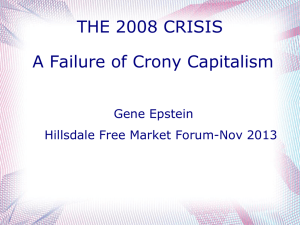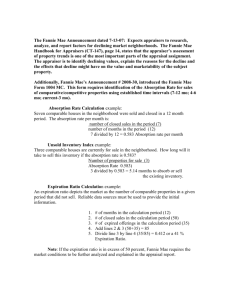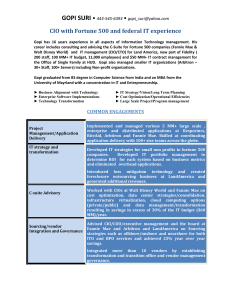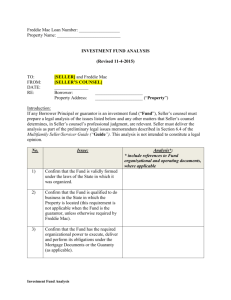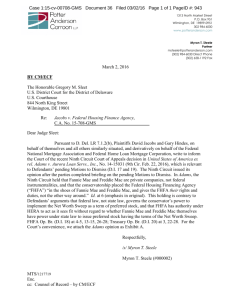Daniel McKeown - pacificpelican.us
advertisement
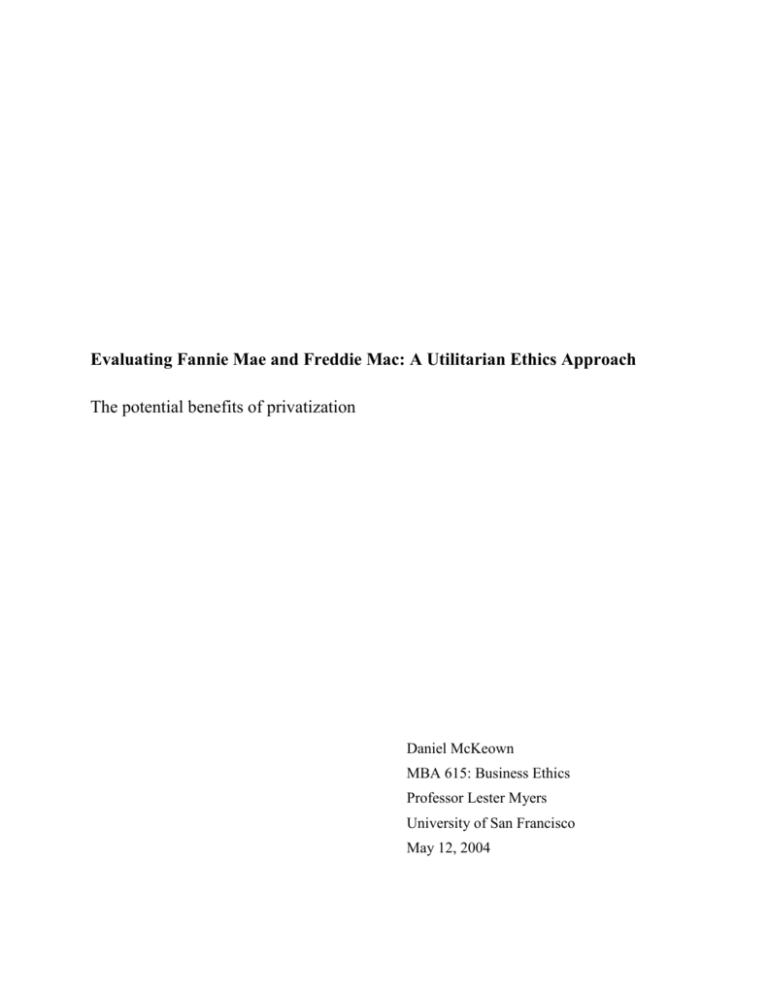
Evaluating Fannie Mae and Freddie Mac: A Utilitarian Ethics Approach The potential benefits of privatization Daniel McKeown MBA 615: Business Ethics Professor Lester Myers University of San Francisco May 12, 2004 Introduction Topic: The topic of this paper is the optimal role for the federally backed mortgage giants Freddie Mac and Fannie Mae in markets and government from an ethical standpoint. Thesis: Fannie Mae and Freddie Mac’s activities result in an overall net loss to society, even when considering mitigating social benefits. The key ethical decision that must be made in this paper is whether to leave Fannie Mae and Freddie Mac in their current form, or to eliminate their subsidy and privatize them. This paper will argue for privatization. Ethical Principle: The guiding ethical principle for this paper is utilitarianism. 2 I. Factual Narrative Fannie Mae and Freddie Mac, two large groups set up by the United States federal government but traded on stock exchanges and able to borrow debt and sell equities privately, are involved in the secondary market for mortgages. Referred to as government-sponsored enterprises (GSEs), they buy the stream of expected payments for one or multiple mortgages in transactions with private banks and financial companies. They put in their portfolio mortgages with higher interest rates than their cost of borrowing. Payments on interest on the mortgages they own accrue to the GSEs, while the money they borrowed to buy the mortgage comes from borrowings by Fannie Mae and Freddie Mac. The difference between those two rates is one of the main ways Fannie Mae and Freddie Mac make money. Fannie Mae and Freddie Mac offer services to the public and are linked to the U.S. federal government. It would be a mistake, however, to assume based on those facts that the companies provide a public good. The services they offer are divisible and exclusionary— certain amounts of capital are allocated to certain people, dividing up the direct and indirect benefits exclusively among the American consumers who are involved as borrowers in the mortgage market. The mortgage market has been growing rapidly in the last few years, spurred by low interest rates and the sharp increases in home prices in many markets. Expectations of rising interest rates may slow some of the growth. It is worth noting that home prices in the United States are widely considered high. The Economist considered U.S. house prices about 15 percent 3 overvalued in 20031. Given three years of consecutive stock market declines from 2000 through 2002, many buyers of houses are considering the purchase as their key strategic investment. An unwinding of this housing bubble could lead to a decline in the amount of home equity that owners can borrow against. It could also lead to a decrease in consumer spending as the net worth of many individuals would decline in concert with their house values. Given the importance of consumer spending to society, a sharp drop could lead to a drop in economic growth or a recession, which does not benefit the U.S. public stakeholder group or any group in this analysis. For this reason, this paper will recommend rules that seek to create utility for all parties while minimizing adverse effects on the stakeholders. Utility in this paper will be measured in financial terms, using money as a proxy for happiness due to the ease with which monetary amounts can be measured and the use of that practice in economics. Thus an important basis for the arguments in this paper is the microeconomic concept of the deadweight burden. This burden is a loss resulting from economic inefficiencies. Mainstream microeconomics holds that any time a government agency assesses a tax or subsidy, the market is distorted. Because of the shift in the supply or demand curve for a product or service due to a tax or subsidy, prices can become artificially low or high. Any kind of inefficiency, or deadweight burden, of this kind will cause an overall net loss because resources will not be used at optimum efficiency. In order to understand why Fannie Mae and Freddie Mac need to be privatized, it is helpful to consider who the stakeholders are in the companies. Considering who the 1 The Economist online edition, “Castles in hot air,” May 29, 2003. (http://economist.com/displaystory.cfm?story_id=1794899: accessed March 22, 2004) 4 stakeholders are and what order of priority they appear to enjoy will help explain why reform is necessary. II. A. Stakeholder analysis Stakeholders with interests at stake Fannie Mae and Freddie Mac have the same structure, so the following breakdown of stakeholders applies to both of them. The largest and most important stakeholder group is the people of the U.S. Fannie Mae and Freddie Mac were created by the United States federal government. As lawmakers in Congress and the president are elected by the citizens of the United States, they act on behalf of the American public. Obviously, overlap exists among the stakeholder groups. For example, the broad group of the American public includes almost everyone in each of the other groups. However, public policy decisions in a democratic system need to take into account the public good. The U.S. public is the key stakeholder group because it reflects the constituents of the government, which created Fannie Mae and Freddie Mac, as well as representing the overall utility for American society. The second group of stakeholders is the group of mortgage buyers (home buyers) whose mortgages are likely to be purchased in the secondary market. The people whose mortgages are purchased by Fannie Mae and Freddie Mac include those who buy low- to mid-priced homes in America. Whether their specific mortgage is purchased from the home buyer’s original lender or not, these consumers are all affected because Fannie Mae and Freddie Mac are large enough buyers to affect the market. It is not at all self evident that these consumers who receive artificially cheap credit are being benefited. As Fannie Mae and Freddie Mac bring more capital into the mortgage system 5 than would be there under market conditions (such is their stated aim), does this allocation of resources even have a positive effect on the mortgage buyer stakeholder group? Home buyers who are given overly generous loans and subsequently find the size of their payments unsustainable and default may not be gaining at all by being extended artificially easy credit. The third stakeholder group is the United States federal government. They passed the laws that created Fannie Mae and Freddie Mac. Congress acts a watchdog over the companies, in its ability to pass legislation that affects the financial sector and because Congress has oversight of federal agencies that include the Office of Federal Housing Enterprise Oversight (Ofheo), which regulates Fannie Mae and Freddie Mac, and is part of the federal Department of Housing and Urban Development. The U.S. government is allowed to borrow in the name of a different stakeholder group, the American people. Clearly the principals of democratic systems, the citizens, have a difficult task in attempting to scrutinize the work of their agents, their elected representatives in the government. Information problems are the main reason—simply aggregating all of the publicly available information on an issue is extremely difficult due to the amount available. In addition, the government often sees the need to classify or restrict information about its activities. Because they are quasi-governmental entities, Fannie Mae and Freddie Mac are not always subject to the same public disclosure requirements governing either private companies or government agencies. Politicians in the United States Federal Government form the fourth group of stakeholders. This group includes those in office, out of office, and seeking office. Members of Congress and the President of the United States are part of the government stakeholder group as well as the politician stakeholder group, the U.S. public group, and possibly other groups. 6 However, many lawmakers have personal ties to the GSEs. Another issue is the political identity of Fannie Mae’s chief executive. A Democrat, Franklin Raines was once on Al Gore’s list of potential Vice Presidential nominees2 and is known as a Washington insider. A major political activity is the television advertising that Fannie Mae employs. Certainly it may be difficult to distinguish between the kind of public relations commercials aired by private companies and the commercials run by Fannie Mae. But an important observation is that the Fannie Mae commercials do not advertise a specific product or service, or stress charitable activities that the company engages in on the margins. Instead, they present an explicitly normative, publicservice oriented vision of what the company does—they talk about helping low-income people to buy houses and how important that is for America. The point is that Fannie Mae does not present itself as a company with any motives besides altruistic ones—a notion that the shareholder stakeholder group would not support. The close relationship of some influential lawmakers with the GSEs has helped to block reforms in the last few years, and Fannie Mae and Freddie Mac are well known for their lobbying activities. Freddie Mac has recently been forced to oust its top lobbyist due to an investigation by the Federal Election Commission.3 Fannie Mae and Freddie Mac’s business customers and partners, who include large financial institutions, are the fifth stakeholder group in this analysis. Private companies hold assets backed by the GSEs. Many of them act as both borrowers and creditors with respect to the GSEs through different financial instruments. One popular one is a “securitized” group of mortgages which includes the future payments from a group of mortgages and can be traded 2 Ryan Lizza, “That’s the Ticket,” The New Republic Online, April 3, 2000. (http://www.tnr.com/040300/lizza040300.html: accessed April 3, 2004) 3 James R. Hagerty, “Freddie Mac Ousts Lobbyist Amid Election-Law Probe,” The Wall Street Journal, March 12, 2004, sec. A. 7 easily. If Fannie Mae or Freddie Mac becomes insolvent, many lenders and bond owners around the world would be adversely affected. It is clear that as well as doing business with commercial banks, Fannie Mae and Freddie Mac also compete with them, and the lenders stakeholder group is disadvantaged when competing with Fannie Mae and Freddie Mac. The upshot is that these banks and financial institutions have to raise capital through equity and debt just like Fannie Mae and Freddie Mac but do not enjoy the ties to the U.S. federal government that allows Fannie Mae and Freddie Mac to achieve a lower weighted average cost of capital than theirs. Fannie Mae and Freddie Mac’s mission of buying mortgages in the secondary market has the effect of making mortgages cheaper by freeing up capital from the mortgages they buy. Banks can then make another loan that they wouldn’t have if Fannie Mae or Freddie Mac hadn’t bought the previous loan. While increasing the amount of credit available, this process will lead to more banks chasing fewer credit-worthy borrowers. In effect, private mortgage companies are forced to take on higher risks to get the same return. Achieving market discipline by moving Fannie Mae and Freddie Mac’s weighted average cost of capital in line with industry norms could prevent marginal buyers from getting loans they can’t afford and keep ambitious home buyers from over-extending on the size of their borrowings. The employees of Fannie Mae and Freddie Mac are the sixth-ranked group of stakeholders. Ed Freeman’s Stakeholder Theory involves employees of firms in the analysis of the firm’s stakeholders.4 The employees are the ones that make Fannie Mae and Freddie Mac work with their expertise and skills. They need to be valued as stakeholders or they will not work hard, and a downturn in employee productivity will impose costs on all stakeholders. 4 Edward Freeman, “The Politics of Stakeholder Theory,” Business Ethics Quarterly 4 (1994): 409. 8 Is it fair to the employees of Fannie Mae and Freddie Mac if their status is changed? A privatization may reduce the job stability of employees at the companies. They may have chosen their work there out of a sense of public service. Or they may have passed up higher-paying but riskier jobs in favor of perceived job stability at Fannie Mae or Freddie Mac. Another group of stakeholders is the shareholders of Fannie Mae and Freddie Mac, who are ranked seventh and last. Fannie Mae and Freddie Mac shares are traded on American stock markets and widely owned, as are their bonds. It is important to consider the interests of the shareholders in the companies. It is likely that most of them do not expect Fannie Mae and Freddie Mac to be fully privatized. The information that the market gives good lending terms due to the association of the GSEs with the government is likely incorporated into the share price. A key balance must be struck between the interests of the shareholders and the mortgage buyers. These stakeholder groups have the most clearly diametrically opposed interest—they split between them the proceeds of the subsidy that arises from the implicit government guarantee on Fannie Mae and Freddie Mac’s debt. Being outranked in the stakeholder analysis puts the shareholders in the position of disadvantage. This paper in the following paragraphs will seek to justify why such an order was chosen. First, as the goal of this paper is to increase overall utility, the people of the U.S. comprise the first group of stakeholders. It is also worth noting that the people of the U.S. have the final say about what is done with Fannie Mae and Freddie Mac through their government. The second group of stakeholders is a subset of Americans who are home buyers. This group is number two because the GSEs were created in order to increase the utility of this group by making it easier to find a mortgage. 9 As mentioned earlier, the third among the stakeholders is the U.S. federal government. Having created Fannie Mae and Freddie Mac, the government has a great deal of control over their activities and has a considerable stake in their success. Because the GSEs enjoy an implicit loan guarantee, the government may someday be forced to or shamed into bailing them out. The uncertainty surrounding whether such a bailout would occur tends to draw attention to Fannie Mae and Freddie Mac. Fourth among the stakeholders are the elected politicians in the federal government. The reason they are separate from the government is mainly that they come and go while the government has an ongoing obligation to the GSEs. The reason that this stakeholder group must be considered carefully is the amount of personal relationships between executives at the GSEs and individual politicians of both parties. Because Fannie Mae and Freddie Mac might invest in their constituency, lawmakers seek to develop connections. If the politicians do not have their needs considered, real reform of Fannie Mae and Freddie Mac is not likely. Then fifth among the stakeholders are the business and trading partners of Fannie Mae and Freddie Mac. These parties rely on Fannie Mae and Freddie Mac to pay the interest on their bonds because many are heavily invested in the companies. This stakeholder group is usually ranked higher in a company, but a look at how decisions are made regarding Fannie Mae and Freddie Mac reveals that the federal government and politicians hold much more sway as they seem to be deciding whether to back the debt of the GSEs. Sixth among the stakeholder groups are the employees at the companies. It is unclear what the expectations about job stability were of the employees when they started work, but it is likely that they expect more protection from job loss than the typical private-sector employee. Maintaining employee morale is essential, and it is important to try to maximize employee utility whenever possible. Seventh among the stakeholders are the shareholders of Fannie Mae and 10 Freddie Mac. The lack of SEC oversight of the companies and the frequent involvement of the government has relegated shareholders to a very passive role—they have neither the information nor the opportunity to influence the direction of the company. Though they provide an important source of capital, their utility is a concern ranking behind all of the other stakeholders because of this. Privatization would eliminate the politicians and government stakeholder groups and make the responsibilities of the other stakeholders much less ambiguous. B. Key decision maker The U.S. federal government is the key decision maker among the stakeholders. They are in charge of regulating Fannie Mae and Freddie Mac, and they created the entities in the first place. The key ethical decision is whether to leave Fannie Mae and Freddie Mac as they are now or to privatize them. This decision will be made by the federal government through law and rule making that affects Fannie Mae and Freddie Mac. It is significant that the key decision makers are not the same as the two most important stakeholders. The number-one stakeholder group, the people of the U.S., can exercise influence over Fannie Mae and Freddie Mac through another stakeholder group, elected politicians. However, many decisions regarding Fannie Mae and Freddie Mac are made in the federal bureaucracy, which is a part of the U.S. federal government stakeholder group but not part of the politician stakeholder group. III. A. Stakeholder synthesis Ethical approach: Utilitarianism Because this paper uses microeconomic concepts as part of its basis and the issues surrounding financial markets do not change in principle over time, rule utilitarianism is 11 preferable to act utilitarianism. Economic laws are a good foundation for a rule utilitarian theory because both should apply to any situation, regardless of the kind of economic system. This paper’s rules must meet the necessary and sufficient conditions for an authentic utilitarian theory. Do they favor actions that promote happiness and discourage unhappiness? The key test is whether they meet the following conditions: Do they specify utility as a maximization principle? Since this paper is based on the microeconomic principle of achieving maximum efficiency through markets, it clearly seeks to maximize utility. Indeed, the paper sets out how to maximize the utility of all of the stakeholders by letting the market work when possible. A second requirement is that the theory identifies a content for the principle of utility. In this case that content is measured in the intrinsic good of economic value (in other words, money) due to the industry the GSEs are in. If the people of the United States do not have to pay to subsidize Fannie Mae or Freddie Mac then their utility will be improved, so this theory clearly has a means of measurement. The third key question is whether the theory is consequentialist. This area may be the nearest to failing the test that this paper’s theory comes, because one or more of the stakeholders is likely to feel negative consequences. That stakeholder is the government. Finally, the utilitarian theory must also be universalistic. The rules of this paper are clearly that way—the topic in this case is restricted to the United States of America but the rules could easily be applied to any country, and the stakeholders would be recognizable almost anyplace in homologous or analogous forms. Ed Freeman considers those stakeholders who are essential to the company to be narrow stakeholders. These would typically include the shareholders, management, and employees, among others. For most companies, the list of stakeholders in this paper would include both narrow and general stakeholders. But in this paper, every stakeholder is a narrow one. Consider 12 how the GSEs would collapse if just one of these scenarios happened: Employees quitting; creditors losing confidence; shareholders dumping their stock en masse; politicians turning in favor of excessive regulation; the government closing them down; or the U.S. public demanding an end to them. The fact that Fannie Mae and Freddie Mac enjoy a special status under the law (they are not regulated by the SEC like other publicly traded companies), and the fact that they were created by the U.S. government, appears to imply that they owe a fiduciary duty to the government. But the shareholder-ownership structure of the companies clearly outlines an obligation toward owners. That is the conflict at the center of this paper’s analysis—Stakeholder Theory does not take into account two number-one stakeholders. But what other position would shareholders accept in a company? In most companies, the shareholders are key stakeholders, while the government is one of the general stakeholders. But since the government is directly involved with Fannie Mae and Freddie Mac, the order of stakeholders is not immediately obvious, since most existing ethical theory naturally deals either with the private or public sector, not the intersection of the two. B. Contemporary Thinking on Fannie Mae and Freddie Mac Alan Greenspan has weighed in recently on which stakeholders get how much of the benefit from the implicit loan guarantee that Fannie Mae and Freddie Mac receive. As The Economist reported, “Citing a Fed study, Mr. Greenspan told Congress in February that the government guarantee gave the twin companies a funding advantage of forty basis points [0.40%]. However, a mere seven basis points [0.07%] were passed on to mortgage interest rates—an amount too trivial to have a substantial impact on home ownership. The rest went to 13 Fannie and Freddie.5” It follows from this information that the stockholder stakeholder group receives a substantial benefit while the mortgage-buyers stakeholder group is not affected significantly by the subsidy the GSEs receive. Jay Cochran III, writing in Regulation, questions whether Fannie Mae and Freddie Mac are still playing the role they were created for effectively. “It is important to remember that one of the reasons Congress created the GSEs was to help banks and thrifts off-load and spread the risks of mortgage finance by creating an active secondary market in mortgages through the GSEs,” he points out. But they now hold many of their mortgage-related financial products in their portfolios instead of reselling them again in the secondary market. Because of this, “Mortgage-lending risks are concentrating in one place rather than dispersing throughout the economy.6” Although Fannie Mae and Freddie Mac have found their value questioned by many observers, some argue that their service to mortgage market is invaluable, and that their links to the government are central to this: “It is impossible to overstate the importance of credit enhancement in the process of mortgage securitization, one of the most prominent and striking features of the secondary market,” comments Richard Roll in the Journal of Financial Services Research.7 He goes on to say that given the length of mortgages, “credit guarantees from the GSEs, (and from GNMA [Ginnie Mae], FHA [Federal Housing Administration], and VA [Veterans Affairs]), are very long-term commitments and hence are made more credible by the government's association. Mortgage-backed securities (MBSs) would exist only to a limited 5 The Economist online edition, “Playing with Fire,” April 7, 2004. (http://economist.com/displaystory.cfm?story_id=1882980: accessed April 17, 2004) 6 Jay Cochran III, “A new watchdog for Fannie and Freddie?,” Regulation 26, no.3 (2003): 6. 7 Richard Roll, “Benefits to Homeowners from mortgage portfolios retained by Fannie Mae and Freddie Mac,” Journal of Financial Services Research 23, no.1 (2003): 29. 14 extent if every individual mortgage backing each security pool were subject to default risk. Such idiosyncrasy is the enemy of a liquid and active market.” IV. Identification and justification of hierarchy of utility-maximizing rules The first utility-maximizing rule of this paper is as follows: Due to government failure, agency costs, and lack of market discipline, the government should not intervene in a market that can be adequately served by the private sector. As government intervention in markets, whether worthwhile or not, inevitably causes a deadweight burden on society, it is providing neither an economic nor social net gain to society unless concrete proof of gains can be produced. The part-government, part-private sector setup of Fannie Mae and Freddie Mac presents certain agency problems. The U.S. public stakeholder group has the U.S. government act as its agent, and the public must assess the job being done while dealing with the difficulty of imperfect information. If they really are private, market driven companies, then why are Fannie Mae and Freddie Mac not regulated by the Securities and Exchange Commission (SEC) like other publicly traded U.S. companies? Ofheo clearly does not have the same authority over the GSEs as the SEC has over private companies. In a recent example, Fannie Mae agreed under pressure to change accounting methods but only after the SEC became involved in the issue along with Ofheo 8. A weak regulator may serve the interests of the government and politicians stakeholder groups. But the principal of the government, the U.S. public, is not well served by inadequate financial disclosure, and it is clear that the shareholder stakeholder group should be given the same status as their stakeholder peers in other companies. Until Fannie Mae and Freddie Mac are forced to 8 James R. Hagerty, “Fannie to Avoid Restating Results After SEC Accord,” The Wall Street Journal, May 10, 2004, sec. A. 15 disclose information about their activities like other publicly traded companies, they will enjoy another hidden subsidy in the form of not having to reveal as much information as their truly private sector employees. The second rule is that because reforms of inefficient government programs when done right can lead to an overall net increase in utility, part of that utility should be used to compensate those stakeholders who experienced a net loss from the change. The costs of privatizing the GSEs that are incurred by the stakeholders other than the U.S. public provide an excellent example of why this rule is necessary. The net losses incurred by the stakeholders that have most to gain from the current system, though lower than the overall benefits, could be very high if a privatization were attempted without a consideration of their interests. A third rule in this paper is that shareholders should not receive returns that are artificially high due to government intervention. Government-backed companies issuing stock like Fannie Mae and Freddie Mac illustrates the kind of policy that benefits a narrow group of stakeholders while distributing even higher costs over a large group. As overall utility is diminished and shareholders are rewarded, a kind of regressive tax is effected due to the government’s intervention resulting in gains for shareholders, who comprise a relatively privileged segment of society (the median income of people who own stocks is higher than the median income of those who do not own such securities). Risk-taking is part of buying stocks, so the government backing certain securities also sends the wrong message to the market that returns can be guaranteed. The implicit government backing makes Fannie Mae and Freddie Mac less concerned than fully private companies about going bankrupt, and this creates a moral hazard. The GSEs will be inclined to take on more risk than similarly-capitalized companies, and this lack of concern for market discipline could make the companies more likely to fail. 16 Crowding out capital for other ventures, the overly funded government company will rarely outperform a private competitor that is acting under market discipline. It is possible for the government to prop up the price of some shares for some time, but excessive government promises in the long run can lead to austerity programs and the risk of default. So one must certainly be careful not to offer what seems like high returns for very little risk as the stock of the GSEs may have been perceived. Banking deregulation during the 1980s and 1990s allowed small, local banks to merge with others like them as well as large banks. With the repeal of the Glass-Steagall Act in 1999, even the old divisions between commercial and investment banking that dated back to the Great Depression were removed. As the deregulation process opened up financial markets, one might have expected Fannie Mae and Freddie Mac to be regarded as relics of days of more heavyhanded government intervention. Instead, the companies have seen massive growth in the last five years. Are they still essential for a functioning mortgage market? Calling for the companies to be privatized, as this paper does, should require a convincing argument that the financial system wouldn’t be more harmed than helped by such a change given the current situation. The fourth rule of this paper is that governments have an obligation to maintain financial stability. Even if one is immune to the arguments for market discipline and sees home ownership as a valuable, intrinsic good that is desirable at any and all costs, one must still consider the possibility of a large, systematic financial failure resulting from the investing activities or derivatives positions of Fannie Mae and Freddie Mac. One reason a default by Fannie Mae and Freddie Mac could be so problematic is that many foreign governments hold some of this debt as foreign reserve. Another key issue is that the U.S. government has only recently taken steps to explicitly reject the notion that it implicitly guarantees the debt of the GSEs. A third problem is 17 that Fannie Mae and Freddie Mac trade derivatives, complex financial instruments like interest rate swaps, which allow the GSEs to adjust their risk (or “hedge”) by taking positions on the future direction of interest rates. Fannie Mae and Freddie Mac not only have their income impacted by interest rates in the sense that the market value of their mortgage portfolios is affected by moves in interest rates, but they also have income affected by swaps. The swaps may be used to counter the effects of rate changes on the mortgage portfolio—or to amplify them, in which case the GSEs will be using the derivatives as leverage, which would increase the amount of money a GSE could lose in one day. Already, signs of potential problems are apparent. In the last year, Freddie Mac has been forced to restate reported financial results by about $5 billion9 over the last few years due to an effort to smooth earnings that violated generally accepted accounting principles. The Financial Times has claimed that Fannie Mae may have lost $24 billion by trading derivatives in the last few years.10 Long Term Capital Management’s collapse in 1998 required a New York Federal Reserve orchestrated bailout by Wall Street banks because of concern about systematic problems as many of those banks were counterparties to many of the hedge fund’s positions. Financial collapses can have extremely disruptive effects on economies. Such events tend to cause dislocation, inconvenience, and lost income. It is obvious that billions of dollars of bond interest going unpaid by Fannie Mae and Freddie Mac in the case of a bankruptcy could pose a major risk to the financial system. Their currently unclear status with the federal government only makes the situation less clear. Large-scale financial problems would affect every stakeholder group adversely—the U.S. public may have difficulty getting even reasonable credit terms, the 9 Kathleen Day, “Freddie Mac Lobbyist Told to Quit,” Washington Post, March 4, 2004, sec. E. (http://www.washingtonpost.com/wp-dyn/articles/A28822-2004Mar3.html: accessed March 22, 2004) 10 Dow Jones news service, “Fannie Mae Paid US$25 Bln On Derivatives Trades – FT,” March 10, 2004. (http://sg.biz.yahoo.com/040310/15/3in3i.html: accessed March 23, 2004) 18 U.S. government may have to pay more interest on Treasury bonds, the politicians would receive negative attention from the economic problems. It is clear that financial instability could harm all of the stakeholders. So aside from crowding out other mortgage buyers, the one or both of the GSEs may also be primed to unleash a catastrophic contagion through the financial markets. It is this risk, currently widely underappreciated, that forms the most powerful argument against the GSEs. One stakeholder group, the U.S. federal government, even appears to be considered responsible for the success of the U.S. economy. Some governments have this obligation spelled out by their central bank—the European Central Bank is charged with maintaining price stability, while the U.S. Federal Reserve has a slightly broader mandate that gives it a similar mission. The order of the rules is based on a judgement as to which ones would best maximize utility. The first rule, that the government should not intervene in a market that can be adequately served by the private sector, makes use of a microeconomic concept in a utilitarian context. It is another way of saying that letting the market work leads to the most efficient choices being made, which maximizes utility. The second rule acts to soften the impact of the first—it states that other stakeholders should be compensated if a move is made that maximizes overall utility but reduces utility for that stakeholder. This is a way of ensuring that everyone involved has their utility considered, and a way to get all of the stakeholders to realize that reform will benefit all of the stakeholders. The third rule is that stock investors should not have returns guaranteed by the government. To the extent that people believe in guarantees, adverse incentives are created because more money is invested in the venture than the market would bear. The fourth rule recognizes that sometimes change must be slow—it states that governments have an obligation to maintain financial stability. The reason it is fourth is partly 19 that it cannot always be followed and because it conflicts with many applications of rule number one—some reforms can cause unpredicted instability, and maintaining stability is only worthwhile insofar as it allows the stakeholders to freely pursue their own utility. Given these rules, every stakeholder should have an incentive to support reform except the government. All of the groups will see their utility increase if those rules are followed except the government. The people of the U.S. will have their overall utility increased due to a more efficient mortgage market, and all of the other stakeholders would be compensated. The problem is that it would be very difficult to convince the government to give up powers. V. Objections to arguments One objection to the thesis is that the implicit costs of loan guarantees for Freddie Mac and Fannie Mae do not result in a measurable, tangible cost to society. However, these are hidden costs—just as real, harder to measure. Not only are hidden costs still substantive, even if their impact is distributed in a relatively painless way, but they are also a way of avoiding accountability. Because the government intervention is subtle and requires a bit of explanation, Fannie Mae and Freddie Mac can advertise the “benefits” they provide like artificially cheap mortgage credit while ignoring the considerable costs to the U.S. public stakeholder group that have been discussed in this paper. Some observers may offer different reasoning regarding the net societal value of wider home ownership. Increasing the overall level of home ownership is frequently cited as the key justification for Fannie Mae and Freddie Mac. This goal is questionable under the rules of this paper. First, Alan Greenspan and other have called attention to the limited size of Fannie Mae’s and Freddie Mac’s subsidy to the mortgage market. So what is the justification for companies 20 that, as this paper has shown, serve ill the interest of all the stakeholders except the politicians and government? Borrowers receive loans not subject to market discipline, shareholders do not receive full disclosure of company information, and the U.S. public feels the cost in the form of higher interest rates on Treasury borrowing due to the effects of the implicit loan guarantee given the GSEs. Higher national borrowing costs increases budget deficits or lowers budget surpluses and imposes long term costs on the public stakeholder group in the form of financial volatility and or higher taxes. This process is long and gradual, which makes its real costs easier to ignore, especially for the stakeholder groups that gain from Fannie Mae and Freddie Mac, the politicians and government. Another problem is that the targets of the subsidies from Fannie Mae and Freddie Mac enjoy considerably higher income on average those who can’t afford a house. As government resources are used, under this paper’s rules it should engage in activities that truly benefit all of society from a utilitarian perspective. The strongest argument for maintaining the status quo with the GSEs is for maintaining stability and liquidity in the mortgage market. The empirical evidence for this is unclear—that is why Richard Roll can endorse the role of Fannie Mae and Freddie Mac while Alan Greenspan is more skeptical. The market could adjust to being without the GSEs, but what is unclear is how that adjustment would go. However this paper must consider which of its rules takes priority in this situation. Even though privatizing Fannie Mae and Freddie Mac could violate rule number four (which states that the government needs to try to maintain financial stability), it would follow rule number one, which argues that the government should not become involved in markets where its action will decrease overall utility. Privatizing the GSEs could also preclude 21 any systematic problems in the future arising out of Fannie Mae and Freddie Mac being connected to the government in the future. Conclusion This paper has argued that the two key stakeholder groups, the U.S. public and the mortgage buyers of America, experience a net loss as a result of Fannie Mae and Freddie Mac’s activities. Each stakeholder is promised increased utility but the agents actually running the firms, the government stakeholder group and the shareholder stakeholder groups, seek only to maximize their own utility. Though their interests are important, they are not the most important stakeholders in this analysis. In order to begin to unravel the web of influence around the companies, a full spin-off of the GSEs into truly private sector entities should be attempted. Doing this would increase utility for the main stakeholder group, the people of the U.S. It would likely not affect the second stakeholder group, mortgage buyers, in a considerable way. The other stakeholder groups could be compensated for their loss of utility from the change by the people of the U.S., and all except the government would finish out with greater utility if a privatization were done properly. Both companies have recently felt a great deal of financial scrutiny. Their managers would likely argue that all outstanding accounting issues should be fully worked out before the status of their company changes. These concerns need to be brushed aside lest the managers keep coming up with such issues in order to maintain the status quo. Even if this proposed privatization is done as recommended, employees may have a hard time seeing the gains to their stakeholder group in that scenario. 22 Since the privatization benefits the citizens of the U.S., that group of stakeholders should minimize the loss for the shareholders according to rule two of this paper. Thus the stockholders should be allowed to sell their shares back to the government at a slight premium to their previous three-month moving average at the time that the announcement comes out that Fannie Mae and Freddie Mac are being privatized. Those shareholders who want to own the new company can hold, and those who don’t can sell their shares to the government because the government will be able to sell those and a lot more shares to the public during the privatization. Clearly this utilitarian decision may have downsides for some stakeholders, but this way, loss concentrated on one group will not be great. Indeed, the overall value to society of secure property rights is likely to outweigh the short-lived benefits of seizure of productive assets by governments. Fannie Mae and Freddie Mac may be involved in charitable programs that do not add economic value but are considered part of their mission. In the private sector, these programs are likely to be the first to experience cost-cutting. For this reason, it is important to recognize what activities the company does, such as advising families about credit or funding housing projects, which should be maintained inside the government after privatization because they provide a public good. The Department of Housing and Urban Development could run these programs, but they should be renamed and disassociated with the spun-off Fannie Mae and Freddie Mac. From that point, Fannie Mae and Freddie Mac would be free to coherently pursue the goals of their newly reduced list of stakeholders. 23 Bibliography Cochran, Jay III. “A new watchdog for Fannie and Freddie?” Regulation 26, no.3 (2003): 6. Day, Kathleen. “Freddie Mac Lobbyist Told to Quit.” Washington Post, March 4, 2004, sec. E. (http://www.washingtonpost.com/wp-dyn/articles/A28822-2004Mar3.html: accessed March 22, 2004) Dow Jones news service. “Fannie Mae Paid US$25 Bln On Derivatives Trades – FT.” March 10, 2004. (http://sg.biz.yahoo.com/040310/15/3in3i.html: accessed March 23, 2004) The Economist online edition. “Castles in hot air,” May 29, 2003. (http://economist.com/displaystory.cfm?story_id=1794899: accessed March 22, 2004) The Economist online edition, “Crony capitalism,” June 26, 2003. (http://economist.com/displaystory.cfm?story_id=1882980: accessed March 22, 2004) The Economist online edition, “Playing with Fire,” April 7, 2004. (http://economist.com/displaystory.cfm?story_id=2577440: accessed April 17, 2004) Feldman, Ron. “Estimating and managing the federal subsidy of Fannie Mae and Freddie Mac: Is either task possible?” Journal of Public Budgeting, Accounting and Financial Management 11, no.1 (1999): 81. Freeman, Edward. “The Politics of Stakeholder Theory.” Business Ethics Quarterly 4 (1994): 409. Hagerty, James R. “Fannie to Avoid Restating Results After SEC Accord.” The Wall Street Journal, May 10, 2004, sec. A. Hagerty, James R. “Freddie Mac Ousts Lobbyist Amid Election-Law Probe.” The Wall Street Journal, March 12, 2004, sec. A. Hill, Ronald Paul, Stephens, Debra, and Smith, Iain. “Corporate social responsibility: An examination of individual firm behavior.” Business and Society Review 108, no. 3 (2003): 339. Julius, A.J. “Basic Structure and the Value of Equality.” Philosophy and Public Affairs 31, no.4 (2003): 321. Lizza, Ryan. “That’s the Ticket.” The New Republic Online, April 3, 2000. (http://www.tnr.com/040300/lizza040300.html: accessed April 3, 2004) Myers, Lester A. “Chapter One: Ethical Theory and Practice.” Masagung Graduate School of Management, University of San Francisco, 2004. Handout. Roll, Richard. “Benefits to Homeowners from mortgage portfolios retained by Fannie Mae and Freddie Mac.” Journal of Financial Services Research 23, no.1 (2003): 29. 24
